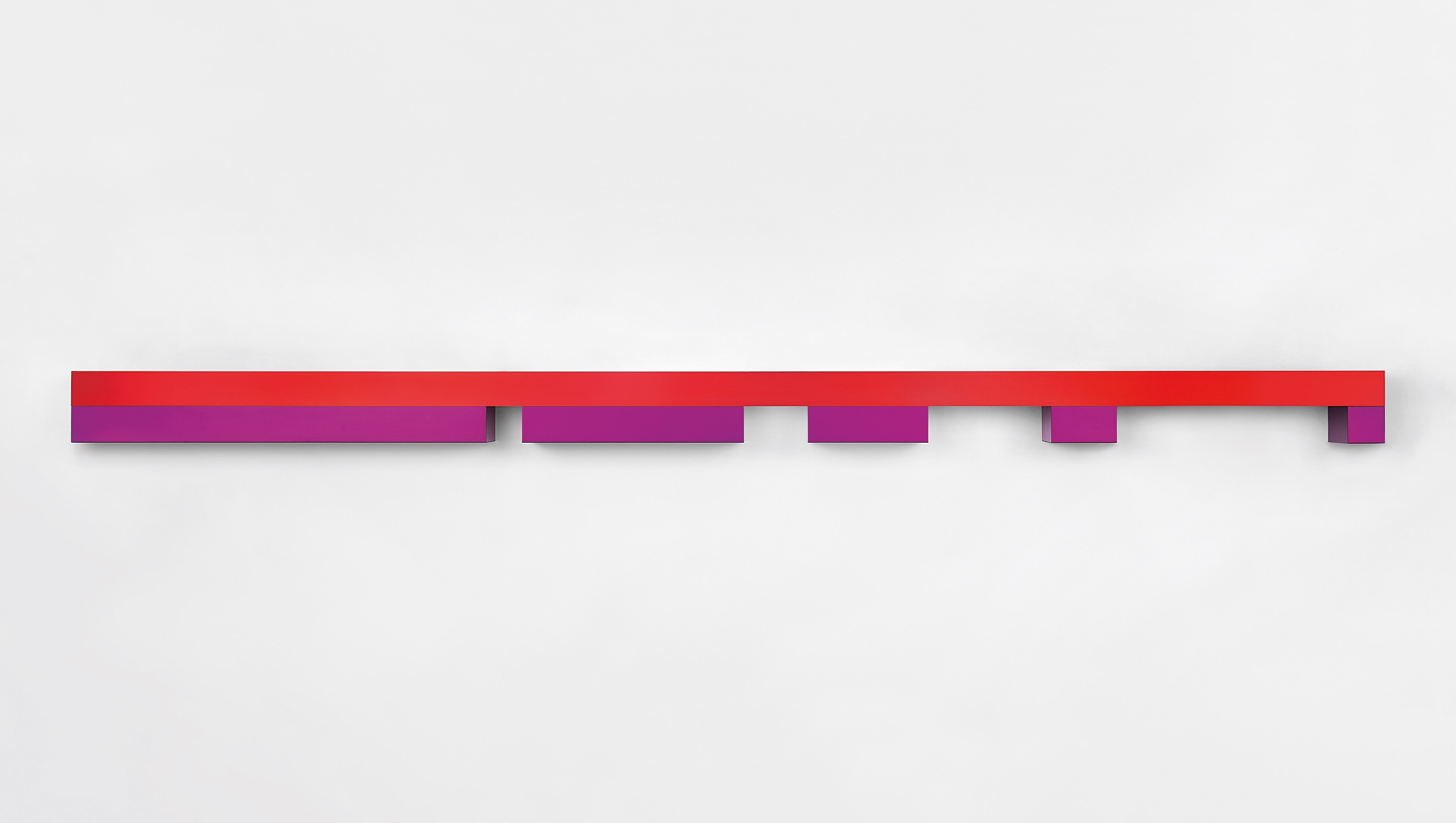

31Ο◆
Donald Judd
Untitled
Full-Cataloguing
With its compelling structural clarity and chromatic brilliance, untitled, 1987, exemplifies Donald Judd’s achievements as a colorist. Composed of anodized aluminum, untitled is defined by the artist’s juxtaposition of red and magenta, a striking variation of a palette that he revisited throughout his career, including in his first examples from this body of work. A wall-mounted piece that Judd defined as a progression, its composition is based on a pre-determined mathematical ratio. Here, a red rectangular aluminum tube defines its nine-foot length, with a series of five magenta boxes below it arranged in a reversal pattern wherein the length of the boxes double in one direction while the intervals between them double in the other direction. Upon viewing the present work from its side, it becomes clear that the long red tube is hollow and cradled by the L-shaped magenta forms, achieving an integration of color, volume, and space.
The chromatic intensity of the red and magenta in the present work highlights the vitality of color in Judd’s oeuvre. Color was an important part of his practice, to the extent that in 1989, he declared: “It’s best to consider everything as color” (Donald Judd, quoted in David Batchelor, Donald Judd, exh. cat., Tate Modern, London, 2004, p. 74). Deeply influenced by the systematic painterly investigations of color by figures including Piet Mondrian and Josef Albers, his works often feature strong hues. Judd was fascinated by red – cadmium red in particular. Discussing his interest in red, he noted that “I thought for a color it had the right value for a three-dimensional object”, and that it “seems to be the only color that really makes an object sharp and defines its contours and angles” (Donald Judd, quoted in John Coplans, Don Judd, exh. cat., Pasadena Art Museum, Pasadena, 1971, p. 25). Judd sought to clearly define volumetric form, not only through his work’s structure, but also through its color.
In addition, Judd gave significant thought to chromatic relationships in his work, avoiding conventional palettes. He wrote: “I especially didn’t want the combinations to be harmonious, an old and implicative idea, which is the easiest to avoid, or to be inharmonious in reaction, which is harder to avoid. I wanted all of the colors to be present at once. I didn’t want them to combine” (Donald Judd, “Some Aspects of Color in General and Red and Black in Particular” in Donald Judd: The Multicolored Works, New Haven, 2014, p. 278). In untitled, the anodized red and magenta hues relate to one another tonally, but avoid both harmony and disharmony, remaining clearly distinct from one another. The colors in the present work relate back to the origins of the series, reversing their chromatic relationship so that red is on top. For the 1964 prototype of his progressions, Judd painted the aluminum linear tube in purple lacquer and its five prismatic elements in light red cadmium oil paint. This in turn led to the 1965 aluminum progression with the same color scheme, now in the collection of the Phoenix Art Museum.
Judd based the compositions of the progressions on known mathematical sequences, including the Fibonacci series, inverse natural numbers, and the reversal pattern seen in the present work. Establishing their proportions according to these defined series allowed him to avoid making subjective compositional decisions as he worked, instead using their pre-determined sequences to create a unified structure. Conceiving a three-dimensional work based on a linear sequence, Judd encouraged viewers to focus on their serial structure and overall unity of form. This versatile format allowed him to revisit the progressions throughout his career, creating variations in their proportions, colors, and materials.
As David Raskin has argued, Judd used “material standardization to create sensory variation” (David Raskin, Donald Judd, New Haven, 2010, p. 79). Judd’s use of anodized aluminum creates surfaces in which color is assimilated as integral rather than a superficial element. This convergence of material and color accords with the artist’s desire to foreground the qualities of his media. Judd created his works in iron, zinc, Cor-ten steel, Plexiglas, plywood, and concrete, all industrial materials distanced from traditional sculptural media like bronze or marble. He applied surface treatments to his metal works that include anodizing, galvanizing, and enameling – methods that allowed him to apply color while retaining their inherent surface qualities. This is compellingly the case with untitled, in which its color and surface operate together to define it as a unified object in real space.
Donald Judd
American | B. 1928 D. 1994Donald Judd came to critical acclaim in the 1960s with his simple, yet revolutionary, three-dimensional floor and wall objects made from new industrial materials, such as anodized aluminum, plywood and Plexiglas, which had no precedent in the visual arts. His oeuvre is characterized by the central constitutive elements of color, material and space. Rejecting the illusionism of painting and seeking an aesthetic freed from metaphorical associations, Judd sought to explore the relationship between art object, viewer and surrounding space with his so-called "specific objects." From the outset of his three-decade-long career, Judd delegated the fabrication to specialized technicians. Though associated with the minimalist movement, Judd did not wish to confine his practice to this categorization.
Inspired by architecture, the artist also designed and produced his own furniture, predominantly in wood, and eventually hired a diverse team of carpenters late in his career.